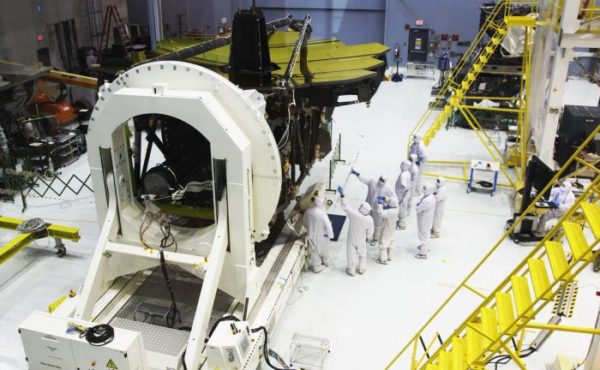Scientists says largest telescope ever launched into space is "incredible"

 NASA’s James Webb Space Telescope is one step closer to completion with the recent unveiling of the huge golden mirror that will form the foundation of the largest telescope ever launched into space.
NASA’s James Webb Space Telescope is one step closer to completion with the recent unveiling of the huge golden mirror that will form the foundation of the largest telescope ever launched into space.
“The mirror installation went exceedingly well,” says John Durning, Webb Telescope Deputy Project Manager from NASA’s Goddard Space Flight Center in Greenbelt, Maryland. “We have maintained our schedule the entire time for installing all 18 primary mirror segments. The telescope is cup up now. So you see it in all its glory!”
The Hubble Space Telescope, launched in 1990, has so far served humanity very well in capturing amazing images of the universe, including the astounding Pillars of Creation of the Eagle Nebula. But with its 4.5 square metre mirror Hubble will be dwarfed by the 25 m2 primary mirror of the JWST, leaving astronomers professional and amateur waiting with bated breath for JWST’s launch, scheduled for October 2018.
Made of beryllium and gold coated, each of the 18 hexagonal-shaped primary mirrors measures 1.3 metres wide and weighs 88 pounds. The mirrors are connected into one structure and folded together and once in orbit they will unfold and into one large 6.4 m2 surface.
Below: James Webb Space Telescope’s Assembled Golden Mirror Is Sight To Behold
The mirrors were built by Ball Aerospace & Technologies Corp., in Boulder, Colorado, principal subcontractor to Northrop Grumman for the optical technology and lightweight mirror system, while the installation of the mirrors onto the telescope structure is being performed by Harris Corporation of Rochester, New York, who will perform integration and testing for the telescope.
“Scientists and engineers have been working tirelessly to install these incredible, nearly perfect mirrors that will focus light from previously hidden realms of planetary atmospheres, star forming regions and the very beginnings of the Universe,” says John Grunsfeld, associate administrator for NASA’s Science Mission Directorate in Washington, in a statement.
Here on Earth, construction is well underway on two ambitious telescope projects, the Giant Magellan Telescope in Chile’s Atacama Desert and the Five hundred meter Aperture Spherical Telescope (FAST) in the Guizhou Province of China.
The Magellan Telescope’s mirror will cover about 368 m2 and will float on an oil-based bearing system, free of friction and vibration. The telescope’s various cameras and spectographs will give unprecedented access to light photons coming from billions of kilometres away (along with having the precision to detect a birthday candle on the moon, according to its promoters).
Magellan is a $1 billion (USD) joint endeavor of the United States, Australia, Brazil, South Korea and Chile and is scheduled to be ready for its first observations in 2022.
A project of the National Astronomical Observatories of the Chinese Academy of Sciences (NAOC) and Australia’s Commonwealth Scientific and Industrial Research Organization (CSIRO), the FAST radio telescope is being proclaimed as the world’s largest single dish telescope -by its name, it’s half a kilometre wide.
“FAST will make it possible for us to look for a range of extremely interesting and exotic objects, like detecting thousands of new pulsars in our galaxy, and possibly the first radio pulsar in other galaxies,” says Professor Rendong Nan of NAOC. Unlike the optical telescopes Hubble, JWST and Magellan which work in the visible light portion of the electromagnetic spectrum, FAST will be a radio telescope, capturing radiation emitted as radio frequencies by galaxies, stars and planets.

